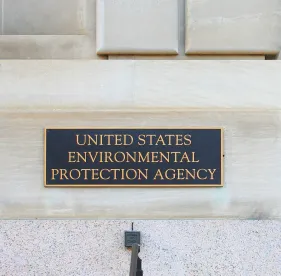EPA recently released its Fall 2020 Regulatory Plan and the Unified Agenda of Federal Regulatory and Deregulatory Actions (regulatory agenda), which includes several important updates to planned actions under the Toxic Substances Control Act (TSCA) (15 U.S.C. § 2601 et seq.), concerning section 5 pre-manufacture notification (PMN) content and review procedures, section 6 risk evaluation and management for existing chemicals, CBI claim procedures, risk evaluation fees, and chemical data collection. While the Biden administration may significantly change the regulatory agenda consistent with its priorities, below we summarize aspects of the current plan affecting chemical control regulation.
New Chemical Reviews
EPA confirmed its plans to propose a rule by May 2021 to revise the TSCA new chemical review regulations (40 C.F.R. Part 720). The revisions are intended to “align [EPA’s] processes and procedures with the new statutory requirements” for PMN decision-making from the Lautenberg Chemical Safety Act of 2016. The rule revisions also are intended to “improve the efficiency of EPA's review process” for PMNs. This will be accomplished by “increas[ing] the quality of information initially submitted in new chemicals notices and improv[ng] the Agency's processes to reduce unnecessary rework in the risk assessment.” Increasing initial PMN quality and reducing rework will help the Agency address ongoing challenges to completing PMN reviews within the statutory 90-day review period. While EPA is barred from requiring a minimum data set for PMN applications, per se, the Agency may elaborate on and expand the information required under existing categories. The rule also may address issues such as better aligning new chemical notice procedures with TSCA’s transparency requirements.
Significant New Use Rules (SNUR)
EPA’s long-awaited final rule updating the hazard communication requirements in the TSCA SNUR regulations (40 C.F.R. Part 721) is nominally scheduled to be released in October 2021. Initially planned for completion in 2017, the schedule for publishing a final rule has been extended several times. Among other things, proposed amendments were intended to align the TSCA SNUR regulations for hazard communication with the revised Occupational Safety and Health Administration (OSHA) hazard communication standard (HCS). The OSHA HCS was updated in 2012 to align with version 3 of the Globally Harmonized System of Classification and Labelling of Chemicals. EPA also proposed allowing manufacturers, importers, and processors to consider removal by wastewater treatment in calculating surface water concentrations when so specified in a specific SNUR that includes a restriction on releases to water.
Risk Management Rules
In response to an industry-led petition for rulemaking submitted to EPA earlier this year, EPA plans to propose a procedural rule for determining TSCA risk management controls and exemptions for existing chemicals that have completed risk evaluation and are found to present unreasonable risks in connection with one or more of their conditions of use. EPA plans to publish the proposed rule in October 2021. The rule is expected to establish consistent risk management rules and standard procedures for Agency collaboration and stakeholder input.
This procedural rule will come too late, however, for those of the first 10 chemicals to undergo TSCA risk evaluation and found to present unreasonable risks. EPA must propose risk management rules for those substances within one year of the determination. Thus far, this includes:
-
Methylene chloride proposed risk management rule: due June 2021
-
1-Bromopropane proposed risk management rule: due August 2021
-
Cyclic Aliphatic Bromide Cluster (HBCD) proposed risk management rule: due September 2021
EPA also completed risk evaluations for carbon tetrachloride, trichloroethylene, and perchloroethylene, but these were completed too late to include their risk management rules in the regulatory agenda. Proposed risk management rules for these substances are expected in November 2021, November 2021, and December 2021, respectively.
As required by TSCA section 6(h), EPA also plans to issue in December 2020 TSCA risk management rules for the following five TSCA “Work Plan” substances asserted to be persistent, bioaccumulative, and toxic:
-
Phenol, Isopropylated Phosphate (PIP) (3:1) final rule
-
2,4,6-Tris(tert-butyl)phenol (TTBP) final rule
-
Pentachlorothiophenol (PCTP) final rule
-
Hexachlorobutadiene (HCBD) final rule
-
Decabromodiphenyl Ether (DecaBDE) final rule
Risk Evaluation Information Collection from Industry
In a strategic shift, EPA deferred until fall of 2021 a planned TSCA §8(a) rule to gather exposure and release information for the remaining TSCA Work Plan chemicals not already under review under TSCA section in some manner. Instead, in March 2021, EPA plans to issue a final TSCA section 8(d) rule that will require the manufacturers and importers of the 20 High-Priority Substances currently undergoing risk evaluation to review their files and submit copies of any unpublished health and safety studies concerning these substances to inform the Agency’s ongoing risk evaluations. The planned rule also would require submission of unpublished health and safety studies from manufacturers and importers of 30 organohalogen flame retardants to inform risk assessment by EPA and the Consumer Product Safety Commission (CPSC).
PFAS Chemical Data Reporting.
The fiscal year 2020 National Defense Authorization Act (NDAA) obligated EPA to undertake a number of regulatory actions concerning per- and polyfluoroalkyl substances (PFAS). The regulatory agenda discloses EPA’s current plan to implement some of those requirements, including a TSCA one-time reporting rule for PFAS manufactured or imported after January 1, 2011, which is scheduled for proposal in April 2021, and revisions to the EPCRA Toxics Release Inventory (TRI) reporting rules to automatically add certain PFAS to the reporting list, expected to be issued as a final rule in January 2021.
Confidential Business Information Procedures
EPA plans to issue a proposed rule in September 2021 to amend procedures for making CBI claims in TSCA submissions, “including substantiation requirements, exemptions, electronic reporting enhancements, and maintenance or withdrawal of confidentiality claims.” It may also address EPA's procedures for reviewing CBI claims and communicating with submitters about confidentiality claims.
TSCA Risk Evaluation Fees
TSCA requires EPA to review and adjust every three years the fees applicable to TSCA new chemical notices and exemption applications, manufacturers subject to TSCA test rules and orders, and manufacturers of chemicals undergoing TSCA risk evaluations. A proposed rule to amend current fees is planned for December 2020 with a final rule due in October 2021. In adjusting the fees, EPA is expected to propose an exemption from risk evaluation fees at least for chemical manufacturers and importers who only (1) import the chemical as part of an article; (2) produce the chemical as a byproduct; or (3) produce or import the chemical substance as an impurity. These revisions follow EPA’s enforcement discretion memorandum, released in March 2020, providing “no action assurance” for these three categories of manufacturers. Other exemptions, such as for R&D chemicals, also may be proposed.






 />i
/>i
